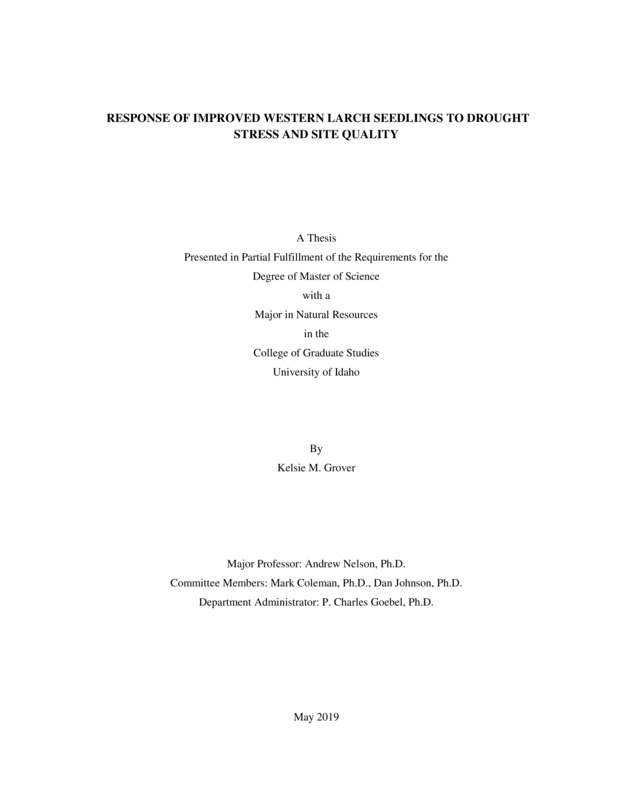RESPONSE OF IMPROVED WESTERN LARCH SEEDLINGS TO DROUGHT STRESS AND SITE QUALITY
Grover, Kelsie. (2019-05). RESPONSE OF IMPROVED WESTERN LARCH SEEDLINGS TO DROUGHT STRESS AND SITE QUALITY. Theses and Dissertations Collection, University of Idaho Library Digital Collections. https://www.lib.uidaho.edu/digital/etd/items/grover_idaho_0089n_11575.html
- Title:
- RESPONSE OF IMPROVED WESTERN LARCH SEEDLINGS TO DROUGHT STRESS AND SITE QUALITY
- Author:
- Grover, Kelsie
- Date:
- 2019-05
- Keywords:
- clone trials drought response gentics tree improvement western larch
- Program:
- Natural Resources
- Subject Category:
- Forestry
- Abstract:
-
Tree improvement remains a valuable and effective way to increase growth and yield in commercially valuable timber species. Significant results have been found in the manipulation of genetics for Pseudotsuga menziesii in the northwestern U.S, Pinus taeda in the southeastern U.S, Pinus raidata in New Zealand, and Pinus sylvestris L. in Europe. Unfortunately, it still remains unclear how western larch performs in genetics trials. Endemic to the Inland northwest and valued primarily for its rapid growth and superior wood quality, western larch is widely planted and managed with intensive silvicultural regimes. In an effort to gain a better understanding of the performance of improved western larch in the field, members of the Inland Empire Tree Improvement Cooperative (IETIC) established a western larch seed orchard in 2007 with families from superior-rated trees. The orchard serves to produce open-pollinated seed for reforestation of cooperative member lands and identify desirable candidates for continued breeding. Seed from seven individual half-sib families in the orchard, selected across a range of regional climates, was collected in 2016. One open-pollinated bulk orchard lot was also collected for this study. Seed was sent to the University of Idaho Pitkin Forest Nursery in 2017 where it was grown and then out-planted the following year for field testing against various site climates and qualities. In 2018, individual families were grown from seed in a greenhouse study to examine genetic by soil moisture effects on seedling morphology and physiology.
The greenhouse drought study was arranged as a Complete Randomized Block Design, with four treatments of increasing drought severity including a well-watered control. Seedlings were germinated in germ cloth, transplanted into D25L Deepots, and then well-watered until secondary leaves flushed. From second leaf flush, the drought trial was applied for 10 total weeks. Seedlings were held at specific gravimetric water contents based on a moisture release curve for the growing media. Three rounds of gas exchange and destructive sampling were conducted in order to obtain photosynthesis, transpiration, specific leaf area, above ground biomass, belowground biomass, and root mass fraction. Height and stem diameter were measured weekly. Results from this study revealed a family and treatment effect on all morphological features, indicating superiority of certain families for drought tolerance during early seedling development. Aboveground development, in mass, height, and stem diameter, and belowground root development were reduced with increased drought intensity. Physiology followed common trends with decreasing photosynthetic and transpiration rates with increased drought severity. Specific leaf area also decreased with increasing drought intensity, indicating increased tissue density. Overall, there was no mortality which could be based on various factors, one of which is high overall water use efficiency in improved stock. Family differences in the morphology indicated some level of drought tolerance within certain seed lots, which could prove advantageous for out-planting performance at drier sites.
The field study was arranged as a Random Complete Block Design, ranging across three different sites each belonging to members of the IETIC and the Intermountain Forestry Cooperative. Each site was selected based on varying soil parent material and moisture regimes. Data collected from the out-planting trial included seedling height, root collar diameter, soil volumetric water content, soil bulk density, soil chemistry, competing vegetation cover, vertical vegetation next to seedlings, and slash loading. Site, soil moisture, and competing vegetation were the most significant factors effecting height growth. There was no family effect on height or diameter. Seedlings at the drier site, Stimson, outperformed seedlings at the wetter site, Molpus, however, Molpus was also the last to be planted and had lower June through August average air temperatures. Total forbs had a negative correlation to height growth as seedlings competed for soil moisture and nutrients. Height of nearby competing vegetation had a positive correlation with seedling height growth. The results from this experiment should be considered short-term findings, however, as it stands they indicated that there is no superiority between families and that half-sib breeding control does not outperform an open-pollinated bulk lot based on site conditions.
- Description:
- masters, M.S., Natural Resources -- University of Idaho - College of Graduate Studies, 2019-05
- Major Professor:
- Nelson, Andrew S
- Committee:
- Coleman, Mark; Johnson, Daniel
- Defense Date:
- 2019-05
- Identifier:
- Grover_idaho_0089N_11575
- Type:
- Text
- Format Original:
- Format:
- application/pdf
- Rights:
- In Copyright - Educational Use Permitted. For more information, please contact University of Idaho Library Special Collections and Archives Department at libspec@uidaho.edu.
- Standardized Rights:
- http://rightsstatements.org/vocab/InC-EDU/1.0/

